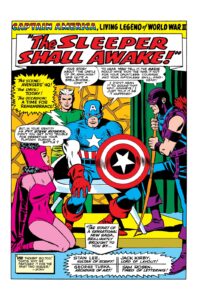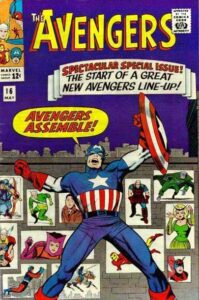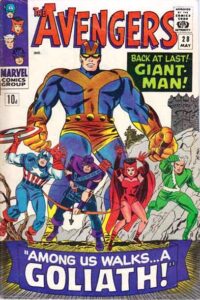The “WandaMySister” Years: Best. Avengers. Ever!
by Will Morgan 13-Feb-21
The younger Avengers became Cap’s surrogate for the family he might have had in a kinder world, and it’s a tribute to Lee’s skill as a writer that Cap’s parental love for his protégés (tempered with impatience!) was tacitly evident.
 In early 1961, Stan Lee was reputedly asked by his publisher, Martin Goodman, to produce a comic book similar to DC’s Justice League of America, a team formed of DC’s major superhero characters, which was going great guns on the nation’s newsstands. Trouble was, Lee’s company—not then known as Marvel Comics—didn’t have any superhero characters. They had had, back in the 1940s and 1950s, but even their biggest stars—Captain America, the Sub-Mariner and the Human Torch—had already been cancelled twice each, and Lee was reluctant to revisit the well for a third attempt.
In early 1961, Stan Lee was reputedly asked by his publisher, Martin Goodman, to produce a comic book similar to DC’s Justice League of America, a team formed of DC’s major superhero characters, which was going great guns on the nation’s newsstands. Trouble was, Lee’s company—not then known as Marvel Comics—didn’t have any superhero characters. They had had, back in the 1940s and 1950s, but even their biggest stars—Captain America, the Sub-Mariner and the Human Torch—had already been cancelled twice each, and Lee was reluctant to revisit the well for a third attempt.
Instead he reinvented the superhero format, creating a dysfunctional family, the Fantastic Four. Battening on to their success, more hits followed—Spider-Man, Iron Man, Thor—so that, a couple of years later, Lee was in a position to create a team of his major heroes, a true equivalent to DC’s Justice League.
The Avengers, launched in 1963, teamed up Iron Man, Thor, the Hulk, and Ant-Man and the Wasp, each of whom was the star of their own series. In issue #4 (March 1964), replacing the early-departing Hulk, whose first run was a surprising flop for Marvel, Lee brought back Captain America, reintroducing the Golden Age hero and giving him a “Man Out Of Time” vibe which resonated with the readership more strongly than a straight revival would have. This stellar team had several epic adventures, and seemed set confidently to rival the JLA in sales and power—but then, with #16 (May 1965), Lee moved the goalposts yet again!
In issue #16, “The Old Order Changeth”, Lee sacked four-fifths of the team. Now, it’s easy to see why Hank and Jan (Ant-Man and the Wasp) were written out—their strip in Tales to Astonish, having been bitten by a radioactive sales report, was about to be cancelled. But Thor and Iron Man were huge hits, so perhaps Lee (at that stage still writing and/or editing virtually everything himself, rather than the multiple author and editor set-up over at DC) wanted to focus more on their solo adventures without the distraction of their involvement in the Avengers.
In any event, Thor, Iron Man, Giant-Man and the Wasp were replaced by three reformed villains—Hawkeye, who had battled Iron Man on numerous occasions, and Quicksilver and the Scarlet Witch, siblings and enemies of the X-Men. It was a ballsy move in story context; Hawkeye was a known thief and Pietro and Wanda, recently members in good standing of the Brotherhood of Evil Mutants, were terrorists, owing to their association with Magneto. Would the readers accept them as heroes?
It was also a daring move commercially; Iron Man and Thor’s presence would have been a huge “crossover” draw to readers. Replacing them with three virtual unknowns—mentored by the remaining Captain America, whose solo feature in Tales of Suspense was less than a year old, and still unproven—could have resulted in Avengers’ swift demise.
Instead, it provided a more intimate dynamic. Freed from the concern of having to co-ordinate the Avenging activities with the solo series (Cap’s strip at the time was set in the Second World War, though it would revert to contemporary tales by the end of the year), Lee could concentrate more on the character interplay which was his strength. “Cap’s Kookie Quartet” became a faux family à la the Fantastic Four, bickering but loyal to each other, with Hawkeye and Quicksilver butting heads to be the young alpha of the pack, while gradually, in tiny stages, the Scarlet Witch emerged from her brother’s shadow, growing in power and confidence.
 There were flaws, of course; Hawkeye’s Johnny-One-Note abrasiveness, ameliorated only occasionally, could become annoying, and Quicksilver’s arrogance begged to be punctured. Equally annoying was his inability to address his sister Wanda without adding the explanatory suffix “my sister”—as if either of them was likely to forget that fact! (Granted, Marvel did, but that was decades later…)
There were flaws, of course; Hawkeye’s Johnny-One-Note abrasiveness, ameliorated only occasionally, could become annoying, and Quicksilver’s arrogance begged to be punctured. Equally annoying was his inability to address his sister Wanda without adding the explanatory suffix “my sister”—as if either of them was likely to forget that fact! (Granted, Marvel did, but that was decades later…)
And while the Scarlet Witch did come forward during this time, that statement has to be qualified by the observation that it was the early 1960s, and “baby steps” were the order of the day. There were glimpses of her potentially devastating powers, but sadly, most of the time, it was still a man telling her when and how to use them. That being said, her effortless takedown in issue #18 (July 1965) of a villain who had defeated all her male colleagues was gratifying.
Above it all, there was the guiding presence of Captain America, shown not as the gung-ho patriot of his vintage iteration, but as a father figure, training his charges, but also caring for them. Having been excised from his own era, the younger Avengers became Cap’s surrogate for the family he might have had in a kinder world, and it’s a tribute to Lee’s skill as a writer that Cap’s parental love for his protégés (tempered with impatience!) was tacitly evident.
This team’s first objective was to locate and recruit the Hulk, as, lacking the raw power of Thor, Iron Man and Giant-Man, they felt somewhat challenged. But their skills and powers, plus instinctive teamwork, proved more than sufficient to their goals, and the idea of Hulk-wrangling was abandoned by the newly-confident quartet. Together, they faced down some of the Avengers’ greatest enemies; the Enchantress and the Executioner, the villain first known as Power Man, traitorous new recruit the Swordsman, time-travelling tyrant Kang, and the Marvel Universes’ “Biggest Bad”, Doctor Doom!
Stan became a little restless with a “second FF”, however, and by issue #26 (March 1966), he began expanding the roster. In that story, Janet Van Dyne, the Wasp, sought the Avengers’ help, and her size-changing sweetheart followed along soon after, under a new nom du guerre of Goliath. Both rejoined the team, and the cast of characters was expanded further when Roy Thomas took over the scripting, with the addition of Hercules, on one of those temporary exiles from paradise that comic-book gods are so fond of. Brash and overwhelming, but benign, Herc filled the “raw power” requirement admirably, while maintaining the focus on interpersonal relationships.
And Cap’s Kookie Quartet became an effective octet with the increasing involvement of the Black Widow, who had graduated from Iron Man’s femme fatale to Hawkeye’s romantic interest. A bad girl gone good, Natasha Romanoff’s shadowed past amped up the drama and angst even as she fought alongside the team, her non-Avenger status proving pivotal to the group’s survival at one point.  This mix of characters, tensions, and romantic subplots kept the audience enthralled and the sales up without the “star power” of the marquee names.
This mix of characters, tensions, and romantic subplots kept the audience enthralled and the sales up without the “star power” of the marquee names.
Sadly, it didn’t endure. Roy Thomas decided to shake matters up in a major way, and with issue #47 (December 1967), Quicksilver and the Scarlet Witch were forcibly recruited by Magneto again—with a head injury to Wanda subsequently rendering her powerless and amnesiac for a tediously protracted period. Other characters were introduced in rapid succession—the heroic version of the Black Knight, the Black Panther, the Vision—as the Avengers changed once more, from an intimate ensemble cast with a “chosen family” feel, to an association of like-minded colleagues with common goals. There were many cracking issues in the title’s future; the quality did not significantly diminish until past #100 (June 1972), but the unique dynamic established in #16, while sustainable through cautious expansion, didn’t survive the free-for-all come’n’go which began with #47.
Recommended issues: Avengers #16 to #46, Annual #1.
Tags: Ant-Man, Avengers, Black Widow, Giant-Man, Goliath, Hawkeye, Hercules, Hulk, Iron Man, Justice League of America, Marvel Comics, Quicksilver, Scarlet Witch, Thor, Wasp
A very interesting read. Avengers #16 is one of my favourite Avengers issues, although that is a rather long list. Nevertheless there is that excitement of so radical a change, where by the end of the issue all of the founding members had been replaced – plus it starts by finishing off the Masters of Evil storyline. I am also very fond of #17. The story is absolute rubbish, but it has this overall feeling of freshness. Lee also avoided the obvious trap of bringing back old villains at the start, although it could be argued that this because they didn’t really have any at this point: Kang had only appeared twice before, the second time in the back ground, and although Mole Man appeared in #17 he was also more in the background as was the Enchantress later on. Oh and of course Zemo was killed in #15.
Overall though, whilst I like the range of issues that you cover, I don’t think they are that great compared to what would come later. To me, Roy Thomas had a slow start with some rather dull stories until about #45, then with that issue things started to warm up, helped greatly by his shake up of the team which effectively took a year (from #47 to #58) – and then he shook up the alter egos of a couple of the members !
I always thought that Thomas would have liked to keep the big three out of the team, thereby giving his stories some freedom, and that the frequent guest appearances were at the instance of Stan to push the sales up, but it turns out that it was the other way around, by the late 60s Stan Lee wanted to reduce the amount of crossovers in Marvel titles to make life easier, whereas Thomas wanted the big boys back in his team.
Anyway, not that you asked, but my favourites from the first 100 issues include (a key word, as there are bound to be some that I forget !) #1, 6, 15-17, 29-30, 52-72, 93. And then there are quite a few that I like nearly as much ! Not to mention all those issues beyond #100….